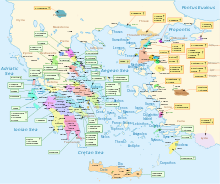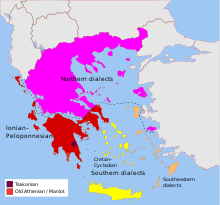
Greek is an independent branch of the Indo-European family of languages, native to Greece, Cyprus, Italy, southern Albania, and other regions of the Balkans, the Black Sea coast, Asia Minor, and the Eastern Mediterranean. It has the longest documented history of any Indo-European language, spanning at least 3,400 years of written records. Its writing system is the Greek alphabet, which has been used for approximately 2,800 years; previously, Greek was recorded in writing systems such as Linear B and the Cypriot syllabary. The alphabet arose from the Phoenician script and was in turn the basis of the Latin, Cyrillic, Coptic, Gothic, and many other writing systems.

Attic Greek is the Greek dialect of the ancient region of Attica, including the polis of Athens. Often called classical Greek, it was the prestige dialect of the Greek world for centuries and remains the standard form of the language that is taught to students of ancient Greek. As the basis of the Hellenistic Koine, it is the most similar of the ancient dialects to later Greek. Attic is traditionally classified as a member or sister dialect of the Ionic branch.

Doric or Dorian, also known as West Greek, was a group of Ancient Greek dialects; its varieties are divided into the Doric proper and Northwest Doric subgroups. Doric was spoken in a vast area, including northern Greece, most of the Peloponnese, the southern Aegean, as well as the colonies of some of the aforementioned regions, in Cyrene, Magna Graecia, the Black Sea, the Ionian Sea and the Adriatic Sea. It was also spoken in the Greek sanctuaries of Dodona, Delphi, and Olympia, as well as at the four Panhellenic festivals; the Isthmian, Nemean, Pythian, and Olympic Games.

Ionic or Ionian Greek was a subdialect of the Eastern or Attic–Ionic dialect group of Ancient Greek. The Ionic group traditionally comprises three dialectal varieties that were spoken in Euboea, the northern Cyclades, and from c. 1000 BC onward in Asiatic Ionia, where Ionian colonists from Athens founded their cities. Ionic was the base of several literary language forms of the Archaic and Classical periods, both in poetry and prose. The works of Homer and Hesiod are among the most popular poetic works that were written in a literary form of the Ionic dialect, known as Epic or Homeric Greek. The oldest Greek prose, including that of Heraclitus, Herodotus, Democritus, and Hippocrates, was also written in Ionic. By the end of the 5th century BC, Ionic was supplanted by Attic, which had become the dominant dialect of the Greek world.

Ancient Greek includes the forms of the Greek language used in ancient Greece and the ancient world from around 1500 BC to 300 BC. It is often roughly divided into the following periods: Mycenaean Greek, Dark Ages, the Archaic or Epic period, and the Classical period.
Modern Greek, generally referred to by speakers simply as Greek, refers collectively to the dialects of the Greek language spoken in the modern era, including the official standardized form of the language sometimes referred to as Standard Modern Greek. The end of the Medieval Greek period and the beginning of Modern Greek is often symbolically assigned to the fall of the Byzantine Empire in 1453, even though that date marks no clear linguistic boundary and many characteristic features of the modern language arose centuries earlier, beginning around the fourth century AD.
Katharevousa is a conservative form of the Modern Greek language conceived in the late 18th century as both a literary language and a compromise between Ancient Greek and the contemporary vernacular, Demotic Greek. Originally, it was widely used for both literary and official purposes, though sparingly in daily language. In the 20th century, it was increasingly adopted for official and formal purposes, until minister of education Georgios Rallis made Demotic Greek the official language of Greece in 1976, and in 1982 Prime Minister Andreas Papandreou abolished the polytonic system of writing for both Demotic and Katharevousa.

In linguistics, diglossia is a situation in which two dialects or languages are used by a single language community. In addition to the community's everyday or vernacular language variety, a second, highly codified lect is used in certain situations such as literature, formal education, or other specific settings, but not used normally for ordinary conversation. The H variety may have no native speakers but various degrees of fluency of the low speakers. In cases of three dialects, the term triglossia is used. When referring to two writing systems coexisting for a single language, the term digraphia is used.
Demotic Greek or Dimotiki is the standard spoken language of Greece in modern times and, since the resolution of the Greek language question in 1976, the official language of Greece. "Demotic Greek" contrasts with Katharevousa, which was used in formal settings, during the same period. In that context, Demotic Greek describes the specific non-standardized vernacular forms of Greek used by the vast majority of Greeks during the 19th and 20th centuries.

Mycenaean Greek is the most ancient attested form of the Greek language, on the Greek mainland and Crete in Mycenaean Greece, before the hypothesised Dorian invasion, often cited as the terminus ad quem for the introduction of the Greek language to Greece. The language is preserved in inscriptions in Linear B, a script first attested on Crete before the 14th century BC. Most inscriptions are on clay tablets found in Knossos, in central Crete, as well as in Pylos, in the southwest of the Peloponnese. Other tablets have been found at Mycenae itself, Tiryns and Thebes and at Chania, in Western Crete. The language is named after Mycenae, one of the major centres of Mycenaean Greece.
Pontic Greek is an endangered variety of Modern Greek indigenous to the Pontus region on the southern shores of the Black Sea, northeastern Anatolia, and the Eastern Turkish/Caucasus region. Today it is spoken mainly in northern Greece. Its speakers are referred to as Pontic Greeks or Pontian Greeks. It is not completely mutually intelligible with modern Demotic Greek.

The Proto-Greek language is the Indo-European language which was the last common ancestor of all varieties of Greek, including Mycenaean Greek, the subsequent ancient Greek dialects and, ultimately, Koine, Byzantine and Modern Greek. Proto-Greek speakers entered Greece sometime between 2200 and 1900 BC, with the diversification into a southern and a northern group beginning by approximately 1700 BC.

Ancient Greek in classical antiquity, before the development of the common Koine Greek of the Hellenistic period, was divided into several varieties.
Ancient Greek phonology is the reconstructed phonology or pronunciation of Ancient Greek. This article mostly deals with the pronunciation of the standard Attic dialect of the fifth century BC, used by Plato and other Classical Greek writers, and touches on other dialects spoken at the same time or earlier. The pronunciation of Ancient Greek is not known from direct observation, but determined from other types of evidence. Some details regarding the pronunciation of Attic Greek and other Ancient Greek dialects are unknown, but it is generally agreed that Attic Greek had certain features not present in English or Modern Greek, such as a three-way distinction between voiced, voiceless, and aspirated stops ; a distinction between single and double consonants and short and long vowels in most positions in a word; and a word accent that involved pitch.
The orthography of the Greek language ultimately has its roots in the adoption of the Greek alphabet in the 9th century BC. Some time prior to that, one early form of Greek, Mycenaean, was written in Linear B, although there was a lapse of several centuries between the time Mycenaean stopped being written and the time when the Greek alphabet came into use.
The linguistic varieties of Modern Greek can be classified along two principal dimensions. First, there is a long tradition of sociolectal variation between the natural, popular spoken language on the one hand and archaizing, learned written forms on the other. Second, there is regional variation between dialects. The competition between the popular and the learned registers culminated in the struggle between Dimotiki and Katharevousa during the 19th and 20th centuries. As for regional dialects, variation within the bulk of dialects of present-day Greece is not particularly strong, except for a number of outlying, highly divergent dialects spoken by isolated communities.
The Greek language question was a dispute about whether the vernacular of the Greek people or a cultivated literary language based on Ancient Greek (Katharevousa) should be the official language of the Greek people. It was a highly controversial topic in the 19th and 20th centuries, and was finally resolved in 1976 when Demotic was made the official language. The language phenomenon in question, which also occurs elsewhere in the world, is called diglossia.
Medieval Greek is the stage of the Greek language between the end of classical antiquity in the 5th–6th centuries and the end of the Middle Ages, conventionally dated to the Ottoman conquest of Constantinople in 1453.
Psilosis is the sound change in which Greek lost the consonant sound /h/ during antiquity. The term comes from the Greek ψίλωσις psī́lōsis and is related to the name of the smooth breathing, the sign for the absence of initial in a word. Dialects that have lost are called psilotic.
Koine Greek, also known as Hellenistic Greek, common Attic, the Alexandrian dialect, Biblical Greek or New Testament Greek, was the common supra-regional form of Greek spoken and written during the Hellenistic period, the Roman Empire and the early Byzantine Empire. It evolved from the spread of Greek following the conquests of Alexander the Great in the fourth century BC, and served as the lingua franca of much of the Mediterranean region and the Middle East during the following centuries. It was based mainly on Attic and related Ionic speech forms, with various admixtures brought about through dialect levelling with other varieties.











